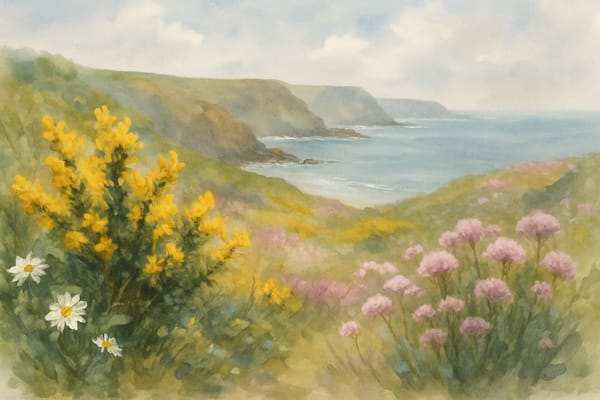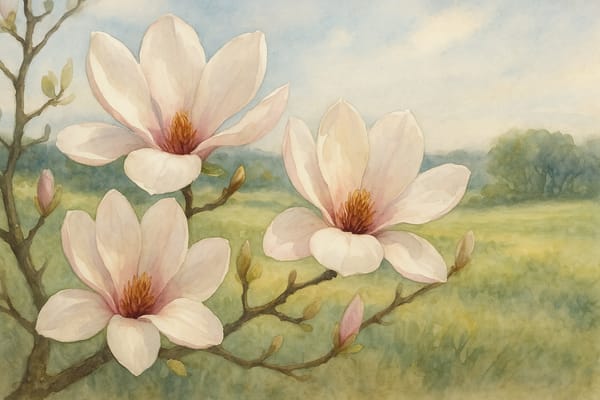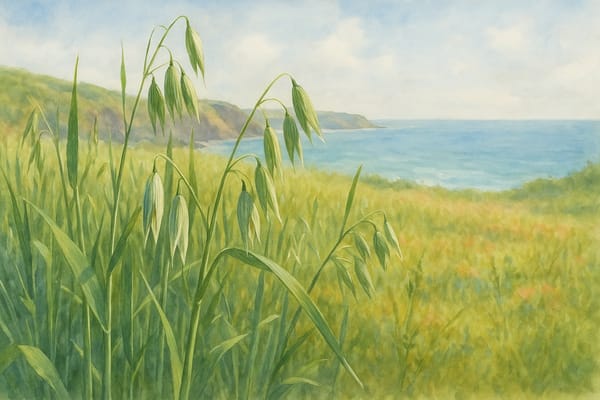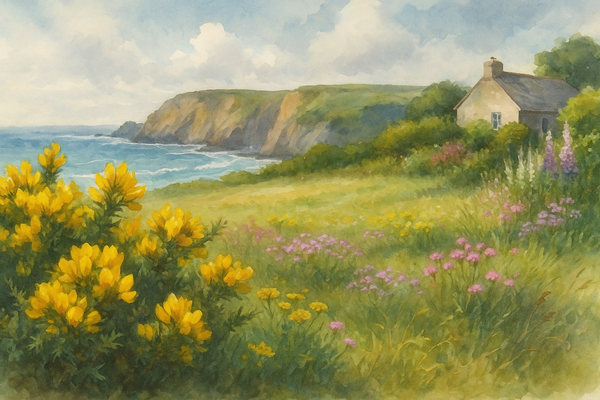There are landscapes we can see, and those we simply feel. In Cornwall, scent is one of the truest forms of terrain—an invisible map of memory, emotion, and belonging that unfolds with each breath.
A coastal breeze carries more than salt and spray. It brings the almond-vanilla drift of gorse blooming gold on the cliffs. The soft hay and apple-threaded scent of camomile rising from a sun-warmed path. The powdery perfume of honeysuckle folding into dusk, delicate and searching. These aren’t just passing fragrances. They are place itself, distilled.
This is the invisible Cornwall. A region not only defined by what it looks like, but what it smells like—and how those smells stay with us, stitching us to time, to land, to feeling.
The Brain’s Secret Garden
Of all the senses, scent is the most intimately tied to emotion and memory. Unlike sight or sound, which are processed through multiple brain regions, smell has a direct route to the limbic system—the emotional heart of the brain.
It’s here, in the amygdala and hippocampus, that smell works its magic. A single breath of crushed mint or a hint of rain on stone can pull memory from the deepest recesses of the mind. This is sometimes described as the Proust Effect, named for Marcel Proust’s description of how a seemingly ordinary sensory moment—in his case, the taste of a madeleine cake—triggered a cascade of rich, involuntary memories. Later interpretations and scientific studies suggest that it is scent, more than taste, that drives this sudden retrieval, often buried for years until reawakened.
Scientific studies have confirmed that scent-evoked memories are more emotional, more immersive, and more enduring than those triggered by any other sense. In one 2013 study, participants reported that smell-linked memories were not only older and more vivid, but also came with a stronger feeling of being transported back in time.
And here lies the true potency of Cornwall’s botanical scents: they don’t just smell beautiful. They carry people back—to a childhood holiday, a forgotten field, a moment of safety or joy long tucked away.
Gorse, Thrift, and the Sea
Cornwall’s aromatic palette is like no other. It’s wind-laced and mineral-bright, shaped by salt, sun, and the lean resilience of plants that have learned to thrive in extremes.
Gorse, for instance, with its warm coconut scent, is a master of memory. Found flowering almost year-round, especially along the coast, it emits a fragrance often described as “sunshine in a plant.” Scientifically, it’s rich in lactones, compounds associated with creamy, nutty sweetness. Emotionally, it conjures freedom, warmth, the long light of childhood afternoons.
Sea thrift, hugging the cliffs in pink tufts, smells faintly of salt and sweet grass. Its scent is barely there—until you notice it, and then it’s everything. A reminder of open skies, wind-tangled hair, a place both wild and still.
Camomile, especially those low-growing near Cornish hedgerows and meadows, releases a soft, apple-honey aroma underfoot. Known for its soothing properties, it also seems to unlock memory gently, as if returning you to a safe place in the mind. This calming effect is more than folklore—camomile contains esters that have been shown to lower anxiety and improve emotional regulation.
Botanical Anchors: Why It Matters
Plants like these form what researchers call olfactory landmarks. They are not just incidental to memory, but integral. They help us map identity, ground our sense of place, and emotionally orient ourselves in a world that often feels unstable.
For those who grew up in Cornwall—or who visited in formative years—the smell of gorse, honeysuckle, or coastal herbs becomes more than a sensory experience. It becomes a kind of emotional shorthand, a way of saying: you were here, you belonged, or something important happened here.
And even for those who discover these scents later in life, the emotional effect can be profound. That’s because aromatic plants don't just trigger memory—they can create new emotional associations, embedding themselves in personal histories with surprising speed and permanence.
When Science Meets Folklore
Long before scientists named the mechanisms of olfactory memory, Cornish communities understood the emotional power of plants.
Honeysuckle was often planted at the threshold of cottages—not just for beauty, but to “welcome love and remembrance.” Camomile was burned in kitchens after a death in the family, believed to calm grief and help the spirit settle. Children were told not to pick thrift near cliff edges, not only for safety, but because it was said to “carry the wind’s sadness” if taken from its place.
These aren’t just superstitions. They’re expressions of a deeper wisdom: that plants are not passive decorations, but emotional companions, holders of memory, protectors of place.
Wellbeing Rooted in Scent
Modern studies in aromachology (the science of scent and mood) back up what traditional practices have always known. Linalool and linalyl acetate—found in Cornish-grown lavender and mint—are associated with lowered cortisol levels, better sleep, and reduced anxiety. Terpenes from gorse and sea herbs have been shown to trigger parasympathetic responses in the nervous system, helping the body move out of stress and into calm.
Walking through a Cornish garden or along a wild coastal path doesn’t just offer visual delight. It can actively regulate your emotional state, clear the mind, and foster a feeling of grounded presence. These benefits are especially potent when the plants are aromatic and regionally rooted—where scent and story are entwined.
Invisible, But Never Forgotten
Perhaps this is why scent matters so much in an age where life often moves too fast. When attention is fractured, when we feel distant from nature or from ourselves, scent brings us home.
A sprig of mint. A jar of dried camomile. A breeze carrying gorse from the cliffs. These are the threads we follow back to meaning—not just in memory, but in the present.
Cornwall’s botanical landscapes are beautiful, yes. But it’s the invisible ones—the ones we carry in our bodies, our memory, our inner weather—that linger longest.
They remind us that landscape is not only what we see, but what we feel.
And sometimes, what stays with us—long after we’ve gone.











